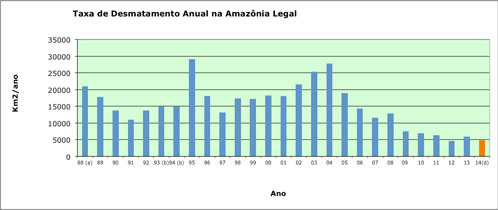The new annual data on Amazon deforestation in Brazil has just come out, and it’s good news. For the latest year—August 2013 through July 2014—the annual total was 4,848 square kilometers. That’s 18 percent less than in the previous year, and the second-lowest figure ever.
But, having cautioned against over-interpreting the numbers last year, when there was a lot of hype in the media about the 28 percent increase compared to the year before, I should repeat the same warning in reverse this year. And in fact neither of these numbers—18 percent down this year, 28 percent up last year—really gets to the most important part of the story.
A look at this graph, from the presentation of the new data by Brazil’s National Institute for Space Research, shows that neither of the last two years’ changes were very large compared to the long-term downward trend:
This year’s decrease, like last year’s increase, was only a minor blip compared to the change over the last decade, which has been a large and historic drop. The numbers that express this best are not the -18 or the +28, but the figures over the past few years compared to the average of the decade from 1996 to 2005, which is what Brazil uses as its official baseline. Compared to that average (which was 19,500 km2/year), deforestation had dropped by 76 percent in 2012 but only by 70 percent in 2013. Now it’s back to 75 percent below the baseline. In other words, during just a decade there has been enormous progress.
Another way to put the new figures in context is to compare them with other tropical countries. The global average rate of tropical deforestation in recent years has been just under 0.5 percent annually. Since Brazil’s Amazon forest region covers a bit over 4 million square kilometers, so the current deforestation figure of 4,848 km2 amounts to 0.12 percent annually – just one-fourth of the global average.
By this criterion, and combining this rate with the fact that over 78 percent of Brazil’s Amazon forest remains standing, Brazil now qualifies as a “High-Forest, Low-Deforestation” (HFLD) country.
Looking at the figures in these big-picture, long-term ways helps correct the misimpressions that one can get from comparing figures year-by-year—or even worse, month-by-month. Deforestation numbers vary because of many things, including the weather (it’s higher in dry months and years), prices and exchange rates for the commodities that drive deforestation, and such simple but vital factors as the amount of cloud cover over the region, which hides greater or lesser areas and thus makes more or less of the deforested area visible in satellite images. Only after several years can we say whether the numbers reflect a real trend, or merely random variation.
Thus, for example, last year there was a lot of speculation (including by me) that the complex 2012 amendments to Brazil’s Forest Code were causing increased deforestation. That may still prove to be the case, but the raw numbers after this year’s drop in deforestation don’t show it. We’ll need more complex statistical analysis to know what effect it really had.
A timely example of this kind of study relates to the soy moratorium, originally adopted in 2006 and extended last week till May 2016 [subscription required]. Scientific studies have shown the effectiveness of the moratorium in reducing deforestation rapidly and in shrinking the carbon footprint of soy to low levels relative to other drivers of deforestation such as beef and palm oil.
In all the discussion of whether deforestation is up or down, another important release of Brazilian data has mostly been missed. These numbers, from INPE’s TerraClass project, ask the question: what happens to land after it is deforested? Usually we don’t even think about this, assuming that once it’s cleared, it stays cleared forever.

Large areas of previously deforested land in Brazil are now growing back as secondary forests. Source: Doug Boucher
But the new TerraClass analysis, corresponding to the period from 2008 to 2012, shows that this isn’t true. Rather, of the 750,000 km2 of Brazil’s Amazon forest that has been cleared, nearly 25 percent is growing back as secondary forest. Most of the rest – nearly 60 percent — has been converted to cattle pasture, with less than 10 percent in crops and under 1 percent occupied by urban areas or mines. So, over multi-year periods, not only has deforestation dropped, but there has also been significant reforestation by natural succession (not by forest planting, which covers less than one-half of one percent of the area).
So, looking back over several years we can see that some very important things are happening in the Amazon, with important benefits for both Brazil and for the global atmosphere. But with numbers covering only a few months or even a year or two, you can easily get the story completely wrong. If journalism, as they say, is “the first draft of history,” maybe we should wait for the scholarly second draft.

